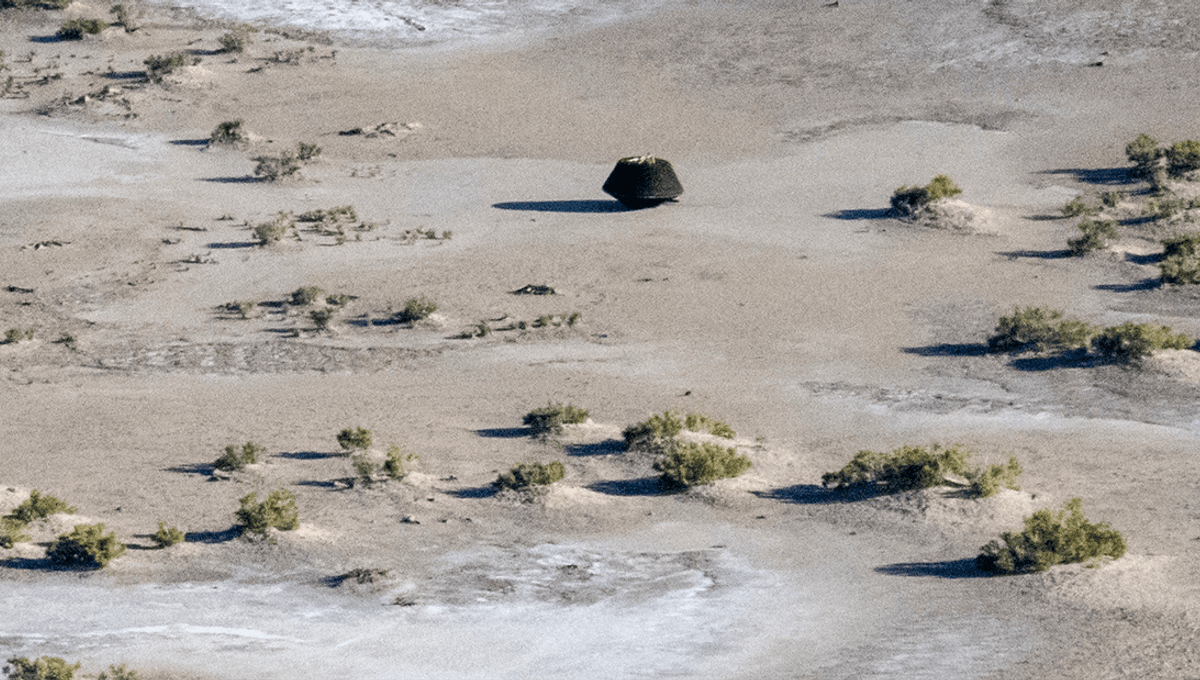
A spacecraft’s sample return capsule was detected entering the Earth’s atmosphere using acoustic sensors by a team of scientists from the Los Alamos National Laboratory and Colorado State University.
ADVERTISEMENT
In 2016, NASA launched an awesome mission to catch up with asteroid Bennu, 320 million kilometers (200 million miles) from Earth. In 2020, the Origins, Spectral Interpretation, Resource Identification, and Security-Regolith Explorer (OSIRIS-REx) probe successfully touched the asteroid briefly, finding a loose collection of debris rather than a solid surface.
In late September 2023, the samples from OSIRIS-REx were delivered back to Earth inside a capsule. Whilst NASA tracked and retrieved the sample return capsule, ready to analyze the samples, another team saw an opportunity for some pretty cool science, using the sample return as an analog for meteor impacts.
“The prediction of shock waves and impacts from meter-size objects is difficult due to the spatio-temporal uncertainties related to their trajectories. Therefore, most recordings of objects entering the atmosphere using geophysical instruments on the ground (e.g., seismometers and infrasound sensors) are serendipitous and the instrument sparsity does not generally allow for a detailed characterization of their trajectory and recordings of the full wavefield,” the team explained in their paper.
They added that “the known trajectory and timing of this return provided a rare opportunity to strategically instrument sites to record geophysical signals produced by the capsule as it travelled at hypersonic speeds through the atmosphere.”
The team placed Distributed Acoustic Sensing (DAS), a “laser-based technology that uses Rayleigh backscattering to detect distributed vibrations (e.g., strain rate) along the optical fibers”, as well as seismometers and infrasound sensors across two sites near Eureka, Nevada, ready to capture the capsule’s descent. This involved laying 12 kilometers (7.46 miles) of optical fiber cables.
When the moment came, it was worth it.
ADVERTISEMENT
“We successfully measured seismoacoustic signals produced by the OSIRIS-REx Sample Return Capsule using DAS, representing the first such measurement with this instrumentation,” the paper reads. “We observed initial impulsive arrivals, with strong coda lasting about a second. Because of the inherent spatial sampling density of DAS, we were able to observe phases that would have been missed otherwise by a standard, more spatially sparse seismoacoustic deployment.”
Using this method, the team got a good look at the sonic boom from the sample capsule, seeing how the wavefront changed as it hit the Earth below. The team believes that this method could be reproduced to get a look at further impacts.
“One of our ongoing objectives is to better understand the physical mechanisms impacting the ground-air coupling of acoustic and seismic phases as they are recorded with surface-draped DAS fiber,” they conclude.
While the team works on this, NASA’s OSIRIS-REx has been renamed OSIRIS-APEX, and will attempt to get up close to asteroid 99942 Apophis following a close encounter by the asteroid with Earth in 2029.
ADVERTISEMENT
“Our planet’s gravitational pull is expected to alter the asteroid’s orbit, change how fast it spins on its axis, and possibly cause quakes or landslides that will alter its surface,” NASA explains of their planned mission. “OSIRIS-APEX will allow scientists on Earth to observe these changes. Additionally, the OSIRIS-APEX spacecraft will dip toward the surface of Apophis – a ‘stony’ asteroid made of silicate (or rocky) material and a mixture of metallic nickel and iron – and fire its engines to kick up loose rocks and dust. This maneuver will give scientists a peek at the composition of material just below the asteroid’s surface.”
The study is published in the journal Seismological Research Letters.
Source Link: Acoustic Sensors Detect Spacecraft's Sample Return Capsule Plummeting Into Earth's Atmosphere